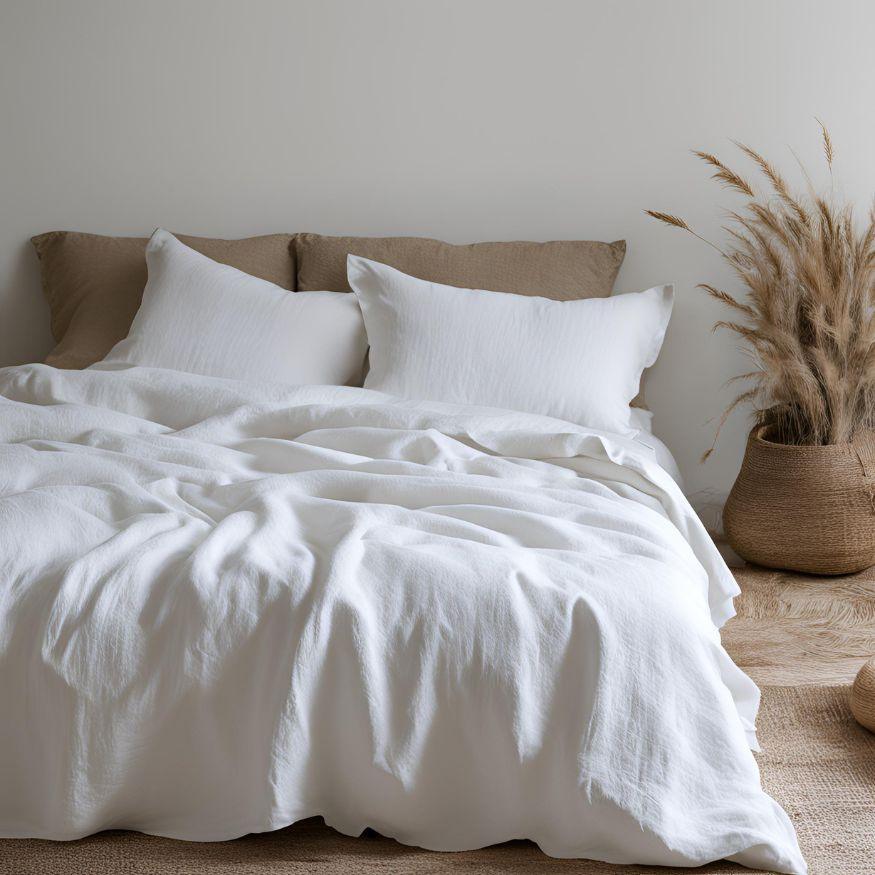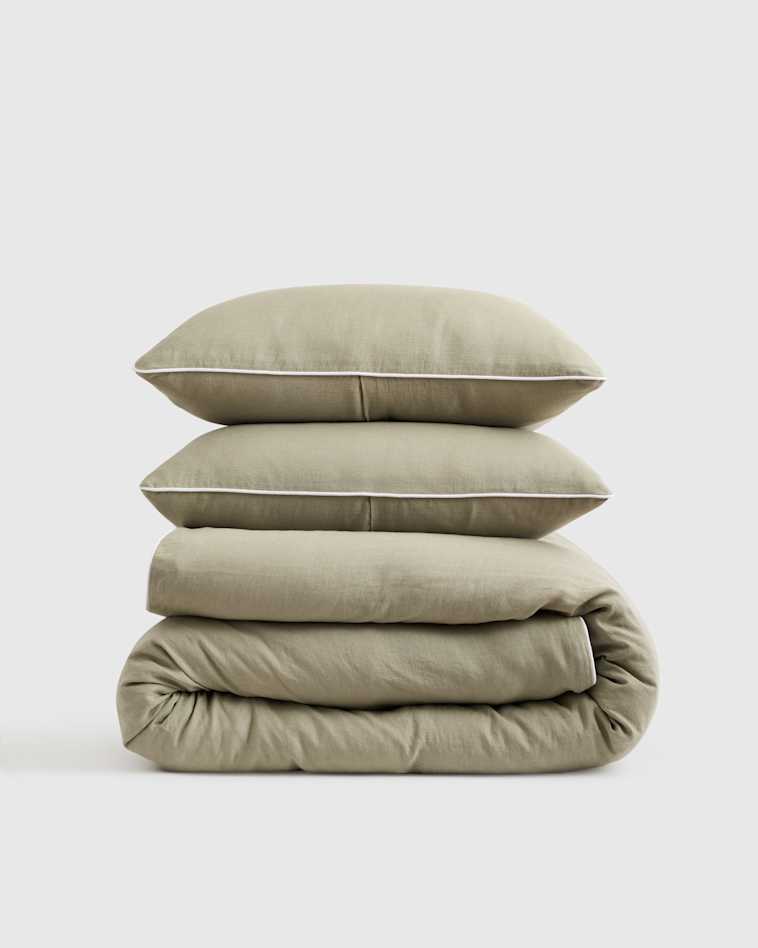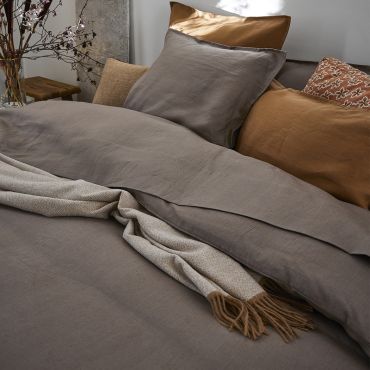Understanding Bed Linen: The Eco-Friendly Option for Comfortable Living
When you believe about environmentally friendly textiles, linen typically stands out for its one-of-a-kind qualities. What really establishes linen apart from other products? Let's check out the fascinating globe of bed linen further.
The Origins of Linen: From Flax to Fabric

Bed linen, among the earliest fabrics recognized to humanity, has an interesting journey that begins with the humble flax plant. You may be surprised to find out that this plant prospers in great environments, prospering in areas like Europe and parts of Asia. As soon as collected, the flax stalks undergo a process called retting, where they're saturated to divide the fibers from the woody components. After retting, the fibers are brushed and spun right into yarn, prepared for weaving.
When you see bed linen material, you're seeing centuries of workmanship. Bed linen has been cherished for its all-natural look and feel, making it a favorite for whatever from clothes to home textiles.
The Distinct Feature of Linen
Among the standout attributes of this remarkable material is its breathability. When you put on bed linen, you'll notice just how it allows air to distribute, maintaining you cool on warm days. This residential or commercial property makes it an ideal choice for summer clothes and bed linens.
Linen additionally boasts extraordinary moisture-wicking capabilities, pulling sweat far from your skin and allowing it to vaporize rapidly. You will not feel clammy, even in moist conditions. Additionally, bed linen is durable, usually coming to be softer and much more comfy with each clean, which suggests it can stand the test of time in your wardrobe.
One more one-of-a-kind facet is its natural structure; the mild abnormalities give bed linen a personality that improves your design. And also, it resists creases better than many other fabrics, so you can enjoy a kicked back yet brightened appearance without much effort. Accept bed linen, and you'll value its comfort and unique beauty.
Environmental Advantages of Linen
When you choose bed linen, you're not simply going with a gorgeous fabric; you're additionally sustaining lasting production practices. Bed linen's compostable and naturally degradable nature makes it a clever selection for the environment. And also, it calls for considerably much less water to produce contrasted to various other fabrics, assisting conserve this valuable resource.
Sustainable Manufacturing Practices
Although several textiles have significant environmental impacts, linen stands out due to its lasting production methods. When you choose linen, you're choosing for a textile made from the flax plant, which requires marginal water and pesticides.
Linen manufacturing is frequently less energy-intensive contrasted to various other fabrics, as it involves all-natural procedures instead than artificial treatments. By supporting bed linen, you're adding to a much more lasting textile industry that focuses on eco-friendly techniques. Picking linen not just boosts your comfort yet likewise aligns your values with environmental obligation.
Compostable and naturally degradable Product
Linen's green nature expands beyond its lasting production; it's compostable and also eco-friendly, making it an exceptional selection for ecologically mindful customers. When you select bed linen products, you're going with materials that damage down naturally, returning nutrients to the planet. This indicates that at the end of their life process, your linen things won't add to garbage dump waste. Instead, they can break down securely, reducing your ecological footprint. Furthermore, composting bed linen can enrich soil, promoting healthy and balanced plant growth. By incorporating bed linen right into your home, you're not just appreciating its comfort and longevity; you're also sustaining green techniques and assisting produce a healthier planet. Welcome bed linen, and really feel good about your options for the atmosphere.
Reduced Water Intake
One of the standout advantages of bed linen is its low water consumption during cultivation. Unlike cotton, which calls for significant irrigation, linen's flax plant prospers on very little water, making it a more sustainable choice. You'll appreciate understanding that for every heap of bed linen generated, considerably much less water is required compared to many various other fabrics.
Linen vs. Other Fabrics: A Contrast
When you contrast bed linen to various other materials, you'll see its exceptional breathability and comfort, making it best for warm weather condition. Plus, bed linen stands out for its sturdiness and long life, often lasting longer than lots of commonly used products. As you consider your choices, the ecological impact of each fabric will likewise play a crucial role in your choice.
Breathability and Convenience
Bed linen stands out amongst products for its remarkable capability to permit air circulation. Unlike artificial materials, which can catch warmth and moisture, bed linen's all-natural fibers wick away sweat, maintaining you completely dry and awesome.
Cotton is usually applauded for its soft qualities, but it does not match bed linen's breathability. If you focus on comfort, particularly in summer season, linen must be your go-to selection.
Longevity and Long Life
While numerous fabrics use differing levels of durability, linen genuinely masters longevity, making it a smart financial investment for your wardrobe. Unlike cotton or artificial materials that might wear out quickly, linen obtains more powerful with each laundry. Its natural fibers withstand fraying and fading, ensuring your garments look excellent gradually. You'll discover that bed linen's breathable nature additionally decreases wear from sweat and wetness, which can damage other textiles. Plus, its ability to withstand heats suggests it will not reduce conveniently in the dryer. You're choosing for a resistant textile that can deal with daily usage while maintaining its beauty when you pick linen. Believe me, your lasting financial investment in bed linen will settle with years of fashionable, comfy wear.
Environmental Impact Comparison
Although several fabrics add to ecological problems, linen attracts attention for its green qualities. Unlike cotton, which calls for massive water sources and chemicals, linen is made from flax, a plant that prospers on very little water and needs fewer chemicals. This means you can feel excellent regarding your choice while lowering your carbon footprint.
When contrasted to artificial fabrics like polyester, bed linen's biodegradability radiates. While polyester can take hundreds of years to decompose, linen breaks down normally, returning nutrients to the soil.
Picking linen not only advertises sustainable farming techniques yet also sustains a healthier planet. By selecting bed linen over traditional textiles, you're making a conscious decision that profits both your convenience and the setting.
Taking care of Your Bed Linen Textiles
To ensure your bed linen textiles remain in fantastic problem, you'll wish to follow some simple treatment guidelines. Initially, wash your linen in chilly water on a gentle cycle to stop it from shrinking or shedding its form. Avoid making use of bleach, as it can damage the fibers. Instead, choose why not try these out for a light detergent that's devoid of harsh chemicals.
When it pertains to drying, air drying is ideal. Choose a reduced heat setup and eliminate the things while they're still somewhat damp to lessen creases if you utilize a clothes dryer. Iron the linen while it's still damp for easier handling, or heavy steam it to maintain it looking crisp.
For storage space, maintain your bed linen in an awesome, completely dry location. Avoid direct sunlight to stop fading. With these easy practices, your linen textiles will certainly keep their charm and last for many years, making them a lasting addition to your lifestyle.
Integrating Linen Into Your Home Design
Caring for your linen textiles not only preserves their top quality yet likewise opens up a world of possibilities for incorporating them into your home decoration. You can begin tiny by including bed linen throw pillows to your couch, immediately elevating the room with texture and warmth. Think about linen curtains that filter sunshine magnificently, producing a soft, ventilated ambience in any room.
For a more rustic appearance, attempt using linen tablecloths or runners during dishes; they include a classy touch and are simple to clean. If you're really feeling daring, mix and suit different bed linen shades and patterns to create a distinct, layered impact.
Do not forget linen blankets-- drape one over a chair or your bed for a welcoming feel. By attentively integrating linen into your design, you enhance both comfort and style, making your home a peaceful resort.
The Future of Bed Linen in Lasting Living
As customers significantly prioritize sustainability, bed linen emerges as a frontrunner in environmentally friendly textiles. Its production uses much less water and chemicals contrasted to conventional cotton, making it a much more ecologically liable option. As you look in the direction of a sustainable future, integrating bed linen into your closet and home can significantly decrease your carbon impact.
Ingenious brand names are now concentrating on lasting methods, from utilizing natural flax to carrying out round economic climate principles. You'll discover that linen's durability implies it lasts longer, lowering the demand for regular substitutes.
Furthermore, as more individuals welcome minimal way of lives, linen's ageless allure and flexibility will certainly maintain it appropriate. By picking linen, you're not just choosing comfort; you're also supporting lasting techniques.
In the upcoming years, the need for bed linen is anticipated to expand, solidifying its location in a more eco-conscious globe. So, consider making bed linen a staple in your sustainable living journey.
Regularly Asked Questions
Is Bed Linen Suitable for People With Allergic Reactions?
Yes, bed linen's all-natural fibers are hypoallergenic, making it appropriate for individuals with allergic reactions. Its breathable nature helps in reducing moisture and bacteria accumulation, adding to a much healthier resting environment. You'll likely locate it comfy and secure.
Can Linen Be Dyed Quickly?
Yes, you can color linen easily. Its all-natural fibers take in dyes well, enabling lively shades. Simply ensure you use the ideal dye type and adhere to proper methods to accomplish the preferred results without harming the material.
How Does Bed Linen Contrast in Longevity to Cotton?

What Weight of Linen Is Best for Summertime Apparel?
For summer apparel, light-weight linen around 4 to 5 ounces per backyard is ideal. It keeps you great, breathable, and comfy in warm my sources climate (Australia Linen). You'll value just how it drapes and steps with you easily

Can Linen Be Used for Outdoor Furniture?
Yes, you can utilize linen for outside furnishings. It's sturdy and breathable, making it a great choice for cozy weather condition. Just make certain to pick a treated version to stand up to the components and keep its look.
Conclusion
Integrating linen right into your life not have a peek at this website only improves your comfort however likewise sustains a much more sustainable future. By selecting this environment-friendly textile, you're making an aware decision that benefits both your well-being and the earth. With its special homes and marginal ecological effect, bed linen is a wise option for your home design and way of living. Embrace linen, and delight in the ideal blend of design, longevity, and sustainability in your day-to-day living.
Linen's biodegradable and compostable nature makes it a smart option for the setting. By integrating linen into your home, you're not just appreciating its comfort and sturdiness; you're additionally helping and sustaining environmentally friendly techniques create a healthier world. The Future of Linen in Lasting Living.
